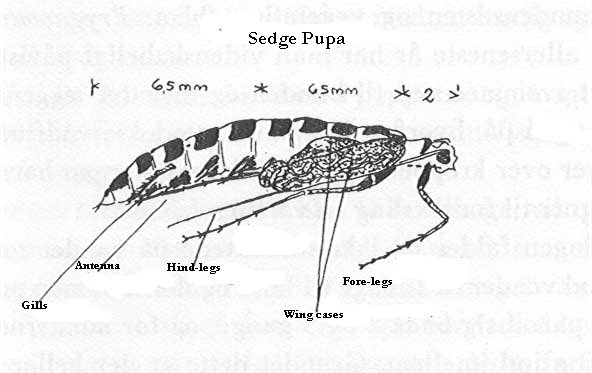Thoughts concerning Flies and Fly Fishing.
Many years ago I had an experience fishing my favorite stream - Binderup creek. After having ended a days fishing I found that at the upper end of our stretch trout - surely rainbows, then it was just near the outlet from a trout farm - were rising steadily. As a challenge I first presented an ordinary, high-floating dry fly - but they rejected every presentation. Then I changed to a fly that only floated in the surface, not upon it, and they took it. It was the favorite of the situation.
Many fishermen has had the same experience;
but few has drawn the conclusion: On many occasions we have to present our flies
so they lay in the surface-film. It's an old knowledge, when we talk about
beetles, Daddy-long-legs, but it is also the fact when it concerns sedges and
dayflies. Many times it can be an advantage to cut the hackles underneath to 'lower'
the fly.
The great hotel proprieter and fly fisher Charles C. Ritz in his famous book
'Pris sur le Vif',
says that it is of utmost importance fishing for grayling that the fly moves
without any disturbances from the cast to which it is attached. Years ago a
french friend of mine fished the famous Norwegian grayling river Glomma. When he
presented his sedge-imitations down-stream and across and let thems move like 'the
hand of a watch' , the graylings 'went haywire' and took every fly he presented
for them!
In May 2000 I visited once more Austria and my host Viktor Sermek brought me in
his car to the small river Fischa, between Vienna and the Hungarian border.
Mayflies were hatching and as a result of bad legs and not fishing any longer I
was placed in a comfortable 'safari-chair' with my digital video-camera, and the
results can be seen undeneath
You can press the key F5 to get a repetition!
The hatching mayflies pop up on the surface;
but then have to rest for a moment before 'take off' - and often they have to
make several attempts, before they finally can fly on to shore and hide in the
vegetation - and these attempts result in stripes in the surface - and the trout/grayling
are attract!
This knowledge is worth having in mind when dayflies are hatching - as my old
friend, the late Oliver Kite wrote in his famous book "Nymph Fishing in Practice'
from 1963 "It is always easier to see what you expect to see, and act
accordingly" or as I have translated it: 'It's always easier to see something,
when you know on beforehand, what to look for'.
I have had a similar observation, when I together with three Swedish friends fished in Norway in July 1977. It was at River Rena (G.E.M. Skues had around 1900 fished on Rena lake from which the river has its origin). The river is absolutely perfect for dryfly- and nymph-fishing - wadable on most stretches and with an ideal flow of water. Already the first evening after our arrival we caught a brace of nice graylings and I collected the stomach content, when we cleaned them. In our camper I placed the stomach-content in a white saucer with water and most of it was a special sedge pupae and some of them still alive - they moved their abdomen up and down. We had a good magnifier and I could see all the finer details - only the middle pairs of legs were free of the pupa skin. I measured them and wrote down their colours. The next day we sharpened our attention on the river surface and in the afternoon we saw stripes on the surface and observing it closer we found out that it was the same pupae and that they moved to the shore on the surface using their legs as oars. Reaching 'terra firma' they shed their envelope and then sought shelter under a stone at the shore.

Later I had a rest sitting at a big stone in the middle of the stream and
shortly after a sedge pupa came swimming and climbed up my waders and I could at
close quaters see exactly how the eclosion took place: It 'stomped' up, then
arched its back, then the head came out of the skin and then its back,
wings and first then it withdraw the hind legs and using these it get rid of the
pupa skin and crawled up and sought shelter under a flap on my fisning vest. We
took advantage of these observations, tied the best imitations we could make and
used them with great succes.
We fished them with casts across the stream. let the fly float a short
stretch, then gave a little tug and then another drift and so on. It was really
'Fishing the Dry Fly as a living Insect" [Leonard M. Wright, Jr. 1971].